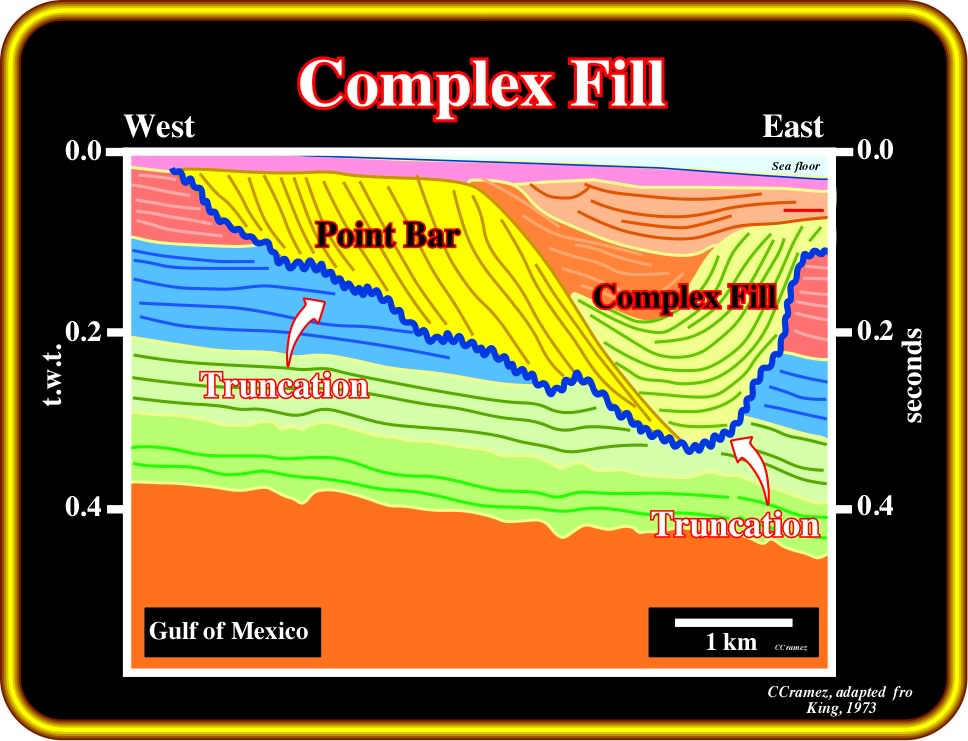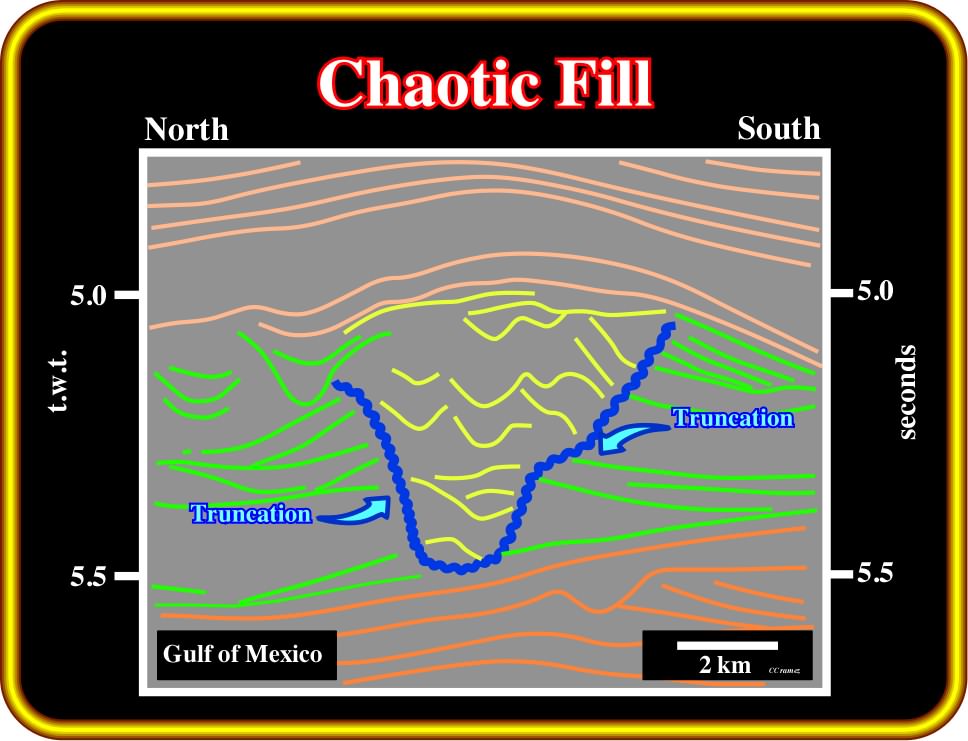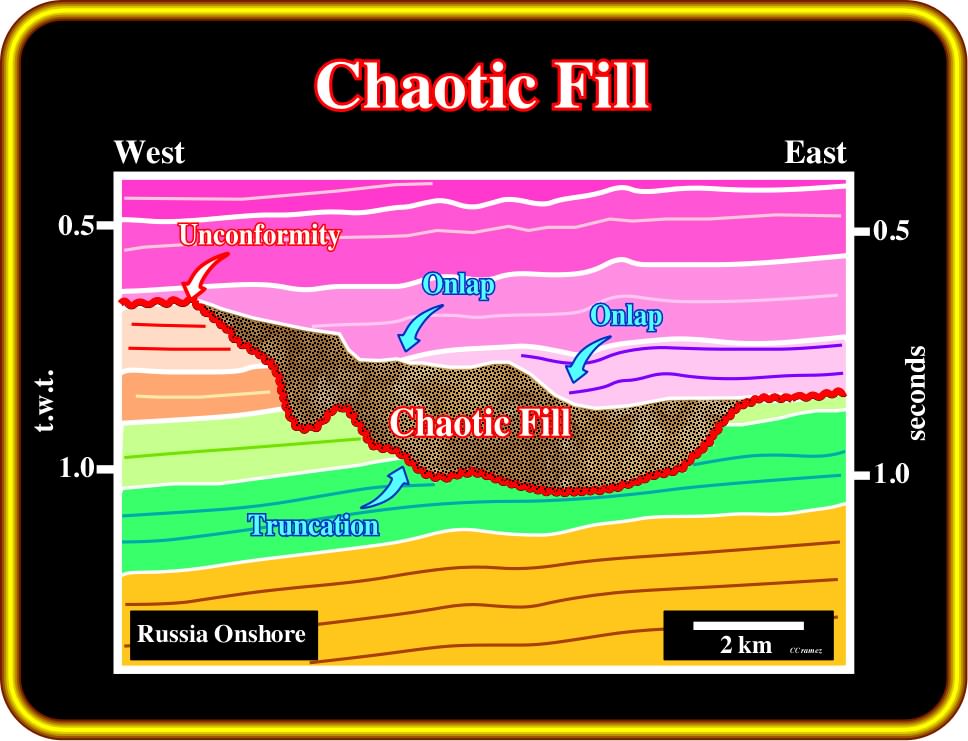

1) Filling Patterns (cont.)

Plate 217- In Angola offshore, near the mouth of the Congo River, external channel fill patterns were filled by deep-water sediments, which, on NW-SE seismic lines, exhibit a doubly convergent configuration. Such a reflection configuration is not observed in a SE-NW seismic line. Subsequently, one cannot say that this doubly convergent configuration is induced by a subsidence change. Actually, in dip seismic lines, roughly parallel to the sediment transportation along the submarine valleys, one can notice the filling is retrogradational, that is to say, it backsteps toward the shelf break. Briefly speaking, as for the reflection terminations, external and internal patterns must be defined on seismic lines parallel to sediment transportation.

Plate 218- In association with halokinesis, compensatory subsidence can induce seismic intervals with divergent configurations striking in different directions. As illustrated on this tentative interpretation of seismic line from conventional Angola offshore, the development of a turtle-back structure (salt induced tectonic inversion), created a stratigraphic interval with quite different divergent configurations. The vergence of the divergent intervals strongly suggests the maximum of compensatory subsidence, i.e., the maximum of salt evacuation with development of a salt weld at the bottom of the turtle-back structure.

Plate 219 - In the upper slope of northern offshore Angola, near the mouth of the Congo river, several submarine valleys characterized by channel fill external patterns, show a complex filling. As usually, the designation complex expresses mainly a mixture of all possible types of internal configurations. In such a conditions, it is quite difficult to hypothesize the main filling mechanism.

Plate 220 - Meander belts are often taken as examples of internal complex filling configuration. As illustrated on this tentative interpretation of an USA offshore seismic line, the external channel fill pattern is obvious. On the contrary, with exception of the point bar, the internal filling configuration is quite diverse and complex. In such fluvial depositional systems, sedimentation and erosion are interrelated and coeval, which creates complicated patterns. Subsequently the seismic onlap surfaces within the complex fill (generally clay plugs) do not correspond to unconformity, that is to say, to relative sea level falls.

Plate 221 - Chaotic filling configurations are often found in association with glacial deposits, such as the one illustrated on this photograph. The clearness of the external channel fill pattern strongly contrasts with the disorder of the internal filling. Chaotic filling configurations are also associated with incised valley (induced by relative sea levels falls that put the sea level below the shelf break), as it is the case in southern Angola onshore (Namibe Moçamedes area).

Plate 222 - On this tentative interpretation of a seismic line from Gulf of Mexico deep-water, the filling of a submarine valley located between overbank deposits (turbidite levees), can unequivocally be considered as chaotic. It is quite difficult to interpret any kind of filling pattern. In spite of the sharpness of the reflection terminations (truncation), some geoscientists do not believe that the truncation seismic surface corresponds to an erosional surface associated with a relative sea level fall.

Plate 223 - On this tentative interpretation, an incised valley was filled by nonmarine sediments creating an external channel fill pattern. No pattern is discernible in the filling interval (chaotic filling). The erosion responsible for the channel fill pattern was induced by a relative sea level fall, which, at the same time, destroys the provisional equilibrium profile of the rivers (there is no definitive equilibrium profile), causing them to incise their beds. The filling of the incised valleys started a new stratigraphic cycle, which continues with the onlap deposition, of transgressive marine sediments.